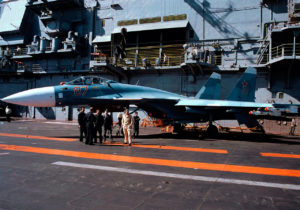Russian ability to project its air power suffered its second major setback in only a few weeks today when a SU-33 jet fighter ended up in the Mediterranean after a landing attempt. This comes on the heels of a somewhat similar incident with a MiG-29K fighter jet a few days ago.
Both incidents share a root cause, one which places a significant question mark on the Russian capability in the area of naval aviation. The cause for both incidents was the Svetlana-2 cable recovery system. The system comprises of four cables that lie on the flight deck and are raised to a height of about five inches when recovery aircraft operations commence. The recovered aircraft is supposed to snag the second or third cable with its tailhook. The other cables are for abnormal recovery and redundancy.
In the first incident, a previously recovered aircraft caught the second cable, which failed and became entangled with the other cables. The aircraft to be recovered next ran out of fuel before repairs to the recovery system could be completed and had to ditch in the sea. The pilot survived with no injury.
In today’s incident, the SU-33 caught the second cable, which then spooled out about 50 meters giving the pilot reason to think that the recovery was successful and throttle back the engines. The cable then snapped and the inertia of the aircraft carried it over the edge of the deck as at that time it was too late to throttle up for a go around. In this case as well, the pilot ejected and survived with no injuries.
While not unprecedented, these incidents point to a number of possible systemic failures in Russian naval aviation. First the recovery system was poorly designed and not tested under simulated combat conditions prior to deployment to a theater of war. Second, it appears that no timely decision was made to redirect the airplane on approach after the recovery system was disabled to a land-based field for landing. This suggests inaccurate reporting and command chain failure. Finally, no decision was taken to halt flight operations until the recovery system failure could be fully understood and eliminated after the first incident.
In aggregate, these failure do not present Russian naval aviation in a positive light.


